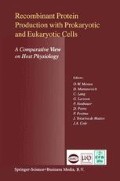Abstract
Production of recombinant proteins using different host systems may lead to a different performance with respect to productivity or selectivity. Therefore, the conditions under which the systems perform may be different A comparison between two systems can only be made when both are cultivated at their optimal conditions. In order to make such comparisons possible one needs optimization procedures which allow to obtain the optima within a few experimental steps only. The straightforward approach to such optimization procedures is model supported optimization. Here we propose an evolutionary strategy by which the optimum of the operational procedure is obtained iteratively in cycles involving predictions and validation experiments.
The strategy will be illustrated at two fed-batch protein productions with very different host cells, thus showing that such a model supported optimization can be successfully used on physiologically significantly different systems. The first example, the optimization of the fed-batch-production of the native recombinant viral capsid protein VP1 with the host cell Escherichia coli, necessitates an optimization of several time-dependent control variables. The non-linear substrate feeding-profile, the time instant for the chemical induction and the profile for the fermentation temperature after induction were optimized simultaneously.
The second example is the optimization of protein production with a recombinant yeast Kluyveromyces lactis. This requires a u-controlled fed-batch-fermentation in order to reduce the byproduct (ethanol, organic acid esters) formation. The central element of the strategy for this particular optimization is series of iterative cycles, consisting of: identification, modeling, optimization, proposal of the fermentation-regime, validation fermentation, and identification.
In both cases it is possible to find optimized fermentation-protocols with only few iteration cycles and to validate the results experimentally. At the same time the backbone of the strategy, the dynamic process model is improved. This model may be a combination of first principle approaches and data-driven heuristics. It can immediately be used to further improve the process by means of advanced model supported control strategies. Such control is highly advantageous when it comes to an industrial production of the protein under consideration.
Access this chapter
Tax calculation will be finalised at checkout
Purchases are for personal use only
Preview
Unable to display preview. Download preview PDF.
References
Galvanauskas, V., Simutis, R., Volk, N. and Lübbert, A. Model based design of a biochemical cultivation process. Bioproc Eng 18 (1998): 227–234.
Kiers, J., Zeeman, A.M., Luttik, M., Thiele, C., Castrillo, J.I., Steensma, H.Y., van Dijken, J.P. and Pronk, J.T. Regulation of alcoholic fermentation in batch and chemostat cultures of Kluyveromyces lactis CBS 2359. Yeast 14 (1998): 459–469.
Salunke, D., Caspar, D.L.D., and Garcea, R.L. Self-assembly of purified Polyomavirus capsid protein VP1. Cell 46 (1986): 895–904.
Schmidt, U., Kenklies, J., Rudolph, R. and Böhm, G. Site specific fluorescence labeling of recombinant Polyomavirus-like particles. Biol Chem 380 (1999): 397–401.
Simutis, R. and Lübbert, A. Advances in modeling for bioprocess supervision and control. In G. Subramanian, (ed.): Bioseparation and Bioprocessing, Vol I. Wiley-VCH, Weinheim/D, pp. 411–461, 1998.
Sonnleitner, B. and Käppeli, O. Growth of Saccharomyces cerevisiae is controlled by its limited respiration capacity, formulation and verification of a hypothesis. Biotechnol Bioeng 28 (1986): 927–937.
Volk, N., Hertel, T. and Lübbert, A. ModellgestQtze Optimierung der Produktion des Virus-Hüllproteins VPl-DHFRmit E. coli BL21. Chem Technik 4 (1998): 192–197.
Zenke, F.T., Kapp, L. and Breunig, K.D. Regulated phosphorylation of the Gal4p inhibitor Gal80p of Kluyveromyces lactis revealed by mutational analysis. Biol Chem 380 (1999): 419–430.
Author information
Authors and Affiliations
Editor information
Editors and Affiliations
Rights and permissions
Copyright information
© 2001 Springer Science+Business Media Dordrecht
About this chapter
Cite this chapter
Volk, N., Franco-Lara, E., Galvanauskas, V., Lübbert, A. (2001). Model Supported Optimization of Fed-Batch Fermentations for Recombinant Protein Production. In: Merten, OW., et al. Recombinant Protein Production with Prokaryotic and Eukaryotic Cells. A Comparative View on Host Physiology. Springer, Dordrecht. https://doi.org/10.1007/978-94-015-9749-4_28
Download citation
DOI: https://doi.org/10.1007/978-94-015-9749-4_28
Publisher Name: Springer, Dordrecht
Print ISBN: 978-90-481-5756-3
Online ISBN: 978-94-015-9749-4
eBook Packages: Springer Book Archive

